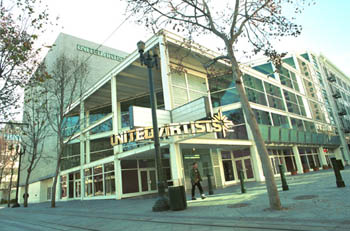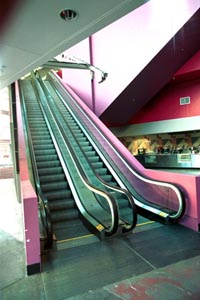![[Metroactive Features]](/features/gifs/feat468.gif)
[ Features Index | San Jose | Metroactive Central | Archives ]
 Photograph by George Sakkestad A Real Smash 'Em Up: Eleven million dollars and four years after it opened, the defunct UA Pavilion Theater in downtown San Jose will be razed, to make way for a high-rise luxury apartment complex with a nine-screen theater on the second floor. Theater Absurd Downtown theater goes down, and new building goes up with luxury apartments, retail, parking and, yes, another state-of-the-art theater By Genevieve Roja AFTER THREE YEARS of financial problems and one year of sitting vacant, the 4-year-old United Artists Theater--once heralded as the cure for downtown San Jose's ailing Pavilion--will succumb to the wrecking ball, says San Jose Redevelopment Director Susan Shick. Shick told Metro last week that it has not been determined exactly when the theater--on South First between San Fernando and San Carlos--will be knocked down and carted away as rubble, but it will likely be in the next couple of years. The other tenants of the Pavilion complex--Internet service company AboveNet, BFGC Architect Planners Inc., Caliber Learning Network Inc., Katie Bloom's Irish Pub, Johnny Rockets and Starbucks--are expected, it is hoped, to remain as the city makes plans for a huge mixed-use housing, retail and parking building in the former theater's place. According to the current proposal by Forest City, the company leasing the Pavilion from San Jose's Redevelopment Agency, the theater will be replaced by a building that includes three levels of parking; 12 floors of luxury apartments; ground space for retail and a second-floor space that will house a theater owned and operated by local independent movie chain Camera Cinema. "The theater is obsolete," Shick says of the 70,000-square-foot, $11 million, 4-year-old theater at the north end of the Pavilion. "It's not a theater built to modern-day standards." Scripted Remarks SHICK'S CONFIRMATION OF the demolition plans capped weeks of nebulous remarks about the future of the defunct theater. Two weeks ago, she told Metro that Camera Cinema was negotiating with Pavilion's landlord, Forest City Commercial Management Inc., but would not elaborate. "Forest City is always looking at various options," was all Shick would say at that time. But the tide on the project appears to have turned. Shick says that in coming weeks the Redevelopment Agency and Forest City will continue discussions and try to iron out more details. "We're working with Forest City to look at the feasibility of the project, financial feasibility and at some of the [other] issues," she added. If Forest City chooses to pursue the project, Shick says they may proceed with presentations to groups and "enter into agreements to revise the current ground lease." As it stands, the Agency owns the land, but it is Forest City that purchased and still owns the Pavilion complex. And since Forest City controls the ground lease, it also controls the proposal, which makes it difficult for the Agency to market the space to anyone else, Shick says.
UNDER THE PROPOSAL outlined by Shick, the new building will be as tall as the Fairmont Hotel and have 12 floors of studio, one- and two-bedroom apartments. Jim Zuur, one of three Camera Cinema co-owners, says the group plans to close its Camera One and Camera Three theaters and relocate them to the new building. On the second floor, there will be six to seven screens with state-of-the-art sound and between 900 and 1,000 stadium-style seats. Shick says the building will be well insulated to assure that occupants are not disturbed by the mixed use. One level of parking will be built underground and the rest will be built into the building. No one offered comment on who will occupy the ground retail space. Forest City purchased the cineplex in 1998 as part of a $73 million deal that included an office building and Pavilion retail shops. "[The new building] will certainly enliven Paseo [de San Antonio], find a new home for Camera and provide some very needed [space for] residential," Shick says. Quiet on the Set SHICK WAS NOT the only official involved who would not talk about the demolition before Friday. In fact, as recently as one week prior, all the parties involved in this landmark development deal--Forest City, the Agency and Camera Cinema--would not make any statements or hint at the planned demolition. Cleveland-based Forest City said only that they had received Zuur's letter of intent and were working on a plan that would be agreeable for all tenants of the Pavilion site, but they were working under no deadline. According to Forest City's Dan Van Leeuwen, a project developer who oversees the development of the Pavilion complex, all parties were still deep in discussion--parties that included the Agency. No one, it seemed, was talking to the main tenant, Camera Cinema. "I'm still hoping to do a project there," Zuur said at that time. "I don't have a deal; we don't have a deal. We have a framework of a deal." Van Leeuwen explained that Forest City had been working continuously with officials at San Jose's Redevelopment Agency since UA vacated the premises one year ago, on Jan. 15, 1999. The Agency, meanwhile, downplayed its role. "We're just a facilitator," said Agency spokesperson Peggy Flynn, when asked about the Agency's role in negotiation talks. Ushering Change THE THEATER turned nontheater was built under the watch of former Agency director Frank Taylor with nearly 5 million in public funds. The financially ailing venue was hurriedly closed in 1999 when UA movers literally carried seats out in the night, bewildering city officials and ticket holders and stranding the local Cinequest Film Festival, which was planning on using its screens. The darkened theater, with its still-good stucco and paint and glass brick entrance, has stood as a mournful reminder of the city's failed, massive investment in the Pavilion, which has, over the past decade, morphed from a planned retail mall to an entertainment center and most recently to an office complex. The UA, which moved into the Pavilion in 1996, says it lost $10 million on the deal. It was paying over $1 million a year in rent, and had spent $6.4 million in original construction costs, compared to the Agency's $4.6 million. The Pavilion shopping center itself, completed in 1990, originally received $10 million in public funding from the Agency. Box Office Bomb WHEN IT HAD OPENED Feb. 16, 1996, the UA Pavilion Theater was supposed to be a commercial godsend, one that would lure suburbanites into downtown San Jose and its restaurants, clubs and shops. But after failing to secure first-run films lost to larger players like AMC and Century theaters, and not being able to show "art films" because of an agreement designed to protect existing downtown theaters, UA felt the heat and backed out of its lease--supposed to expire in 2008-- nearly a decade early. According to Scott Hall, Director of Real Estate for the Englewood, Colo.-based United Artists Theatre Circuit Inc., the January pullout was necessary because of "unprofitability," something which appears to have been contagious among the UA chain in the late '90s. In June 1999, the UA's three-screen complex at the Pruneyard Shopping Center in Campbell closed under similar circumstances that also included poor attendance and increasing rent. Because Hall was not involved with UA's withdrawal from the Pavilion at the time, he has no exact details on who was informed of the covert operation. According to a local news report, movie patrons were surprised that January evening to discover police cars standing by and movers loading projectors and chairs into trailers. Some holding tickets for movie showings that night were told by UA staff that the theater was having technical complications and was due for remodeling. According to Shick, officials were never made aware of the UA pullout until it happened. "In fact, they [UA] had told us they were not going to move out abruptly, and they just did," she said. In early September 1999, UA had indicated that they would vacate the Pavilion, but later postponed its plans, proposing Bally Total Fitness sublease part of the theater and convert the rest of the space to office and retail use. Forest City rejected the idea. Whether Forest City will penalize UA for prematurely abandoning its lease remains to be seen. Shick states adamantly that the Redevelopment Agency has "no relationship" with UA. The matter, she says, is between Forest City and the national movie chain, which filed Chapter 11 bankruptcy and closed more than a score of its theaters last year. Jack Kuhn, President of Forest City Commercial Management, Office Division, says slapping a penalty on UA "is a matter for the judge to decide." Movie Revival ZUUR'S DREAM for the new theater is a sophisticated, state-of-the-art nine-screen theater that includes a restaurant and cafe. Although Zuur would close Camera One on First Street and Camera Three at the corner of Second and San Salvador, the Camera-owned Los Gatos and Towne theaters would remain open. At the revamped Pavilion site, Zuur also hopes to serve high-end sandwiches and salads, similar to the ones currently being sold at the Camera Three theater. Ultimately, movie viewers will be able to order meals directly from their seat--a new industry trend called "cinema dining," which is finding success in theaters nationwide. "They're looking at improving the whole level of service," said Dan Orloff, of Orloff/Williams, the advertising and public relations firm representing Camera Cinema. "Their goal is to create a world-class destination cinema experience." Orloff also disclosed that several Silicon Valley computer companies with Hollywood connections were interested in seeing the Camera Cinema relocation come to fruition. When asked who, Orloff said, "It's too soon to be specific." And contrary to Zuur's feelings that talks were going nowhere, Orloff said that Camera Cinema had sealed its part of the deal by negotiating the terms of a long-term lease agreement. With the latest news, all parties seem satisfied, including Shick. It's as if the building that fell short of everyone's expectations of more downtown traffic, more downtown dollars and, ultimately, more downtown sophistication is being resurrected into the little mixed-use project that could. "I think it's a great proposal," she says. "It's going to add more people, more vitality [to downtown]." [ San Jose | Metroactive Central | Archives ]
|
From the December 21-27, 2000 issue of Metro, Silicon Valley's Weekly Newspaper.
Copyright © 2000 Metro Publishing Inc. Metroactive is affiliated with the Boulevards Network.
For more information about the San Jose/Silicon Valley area, visit sanjose.com.
 High Expectations
High Expectations